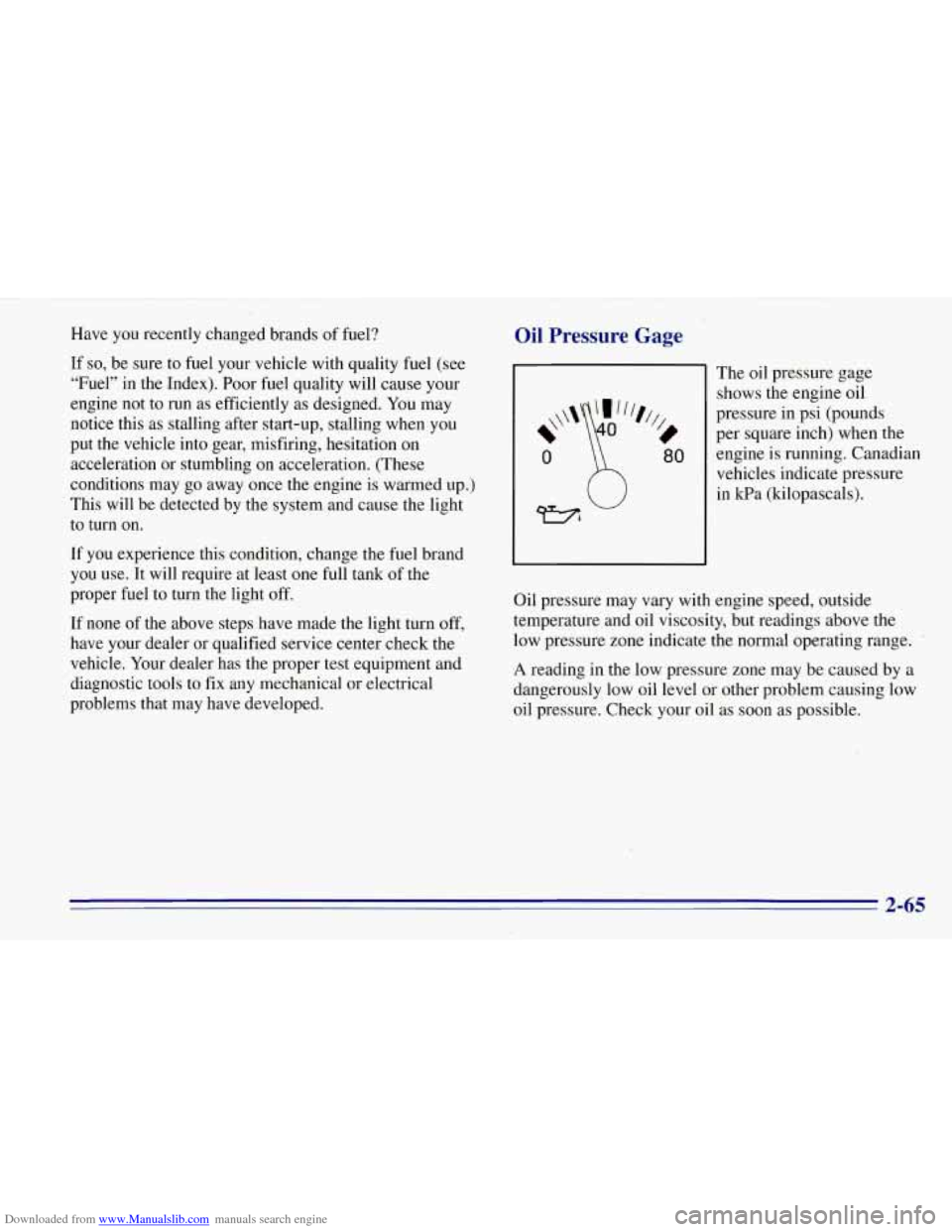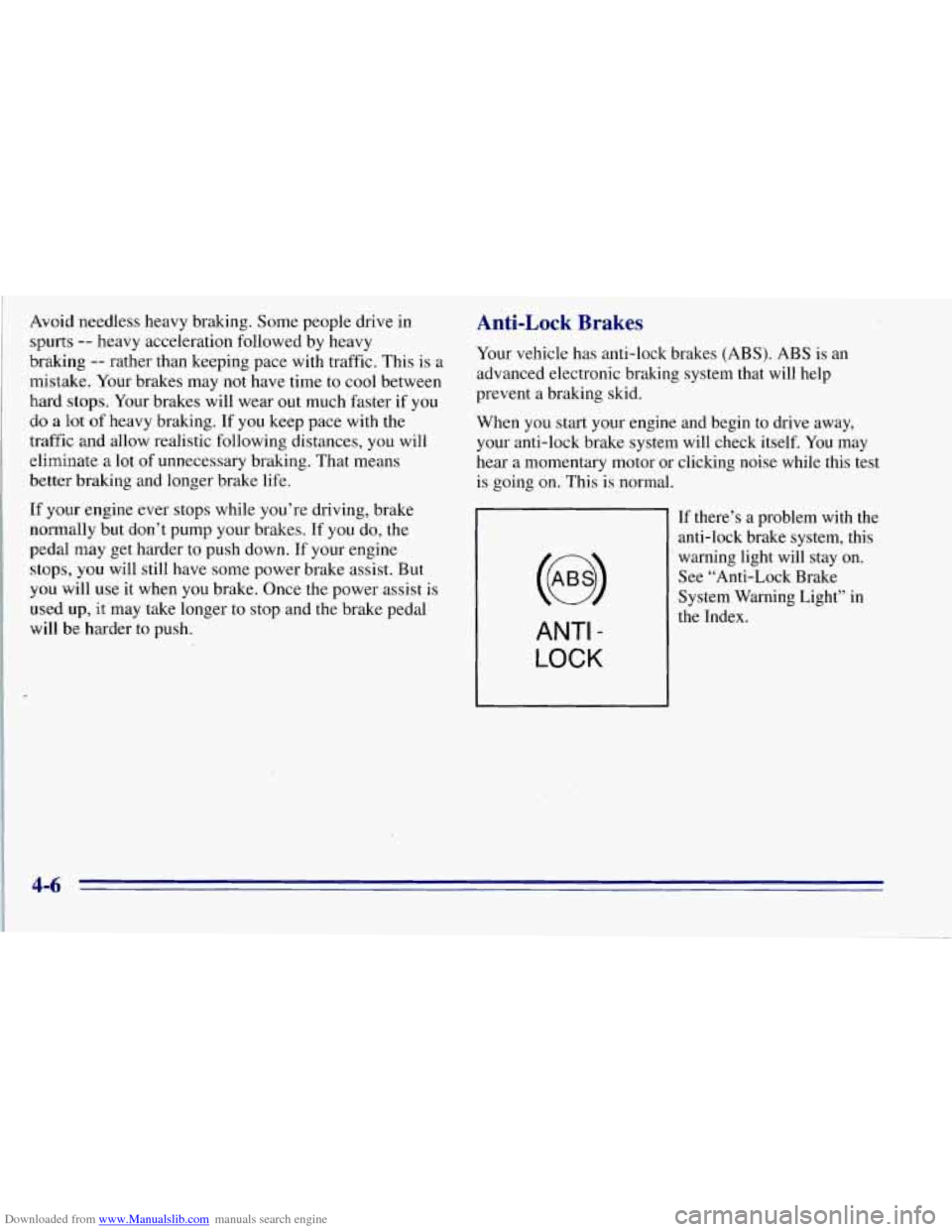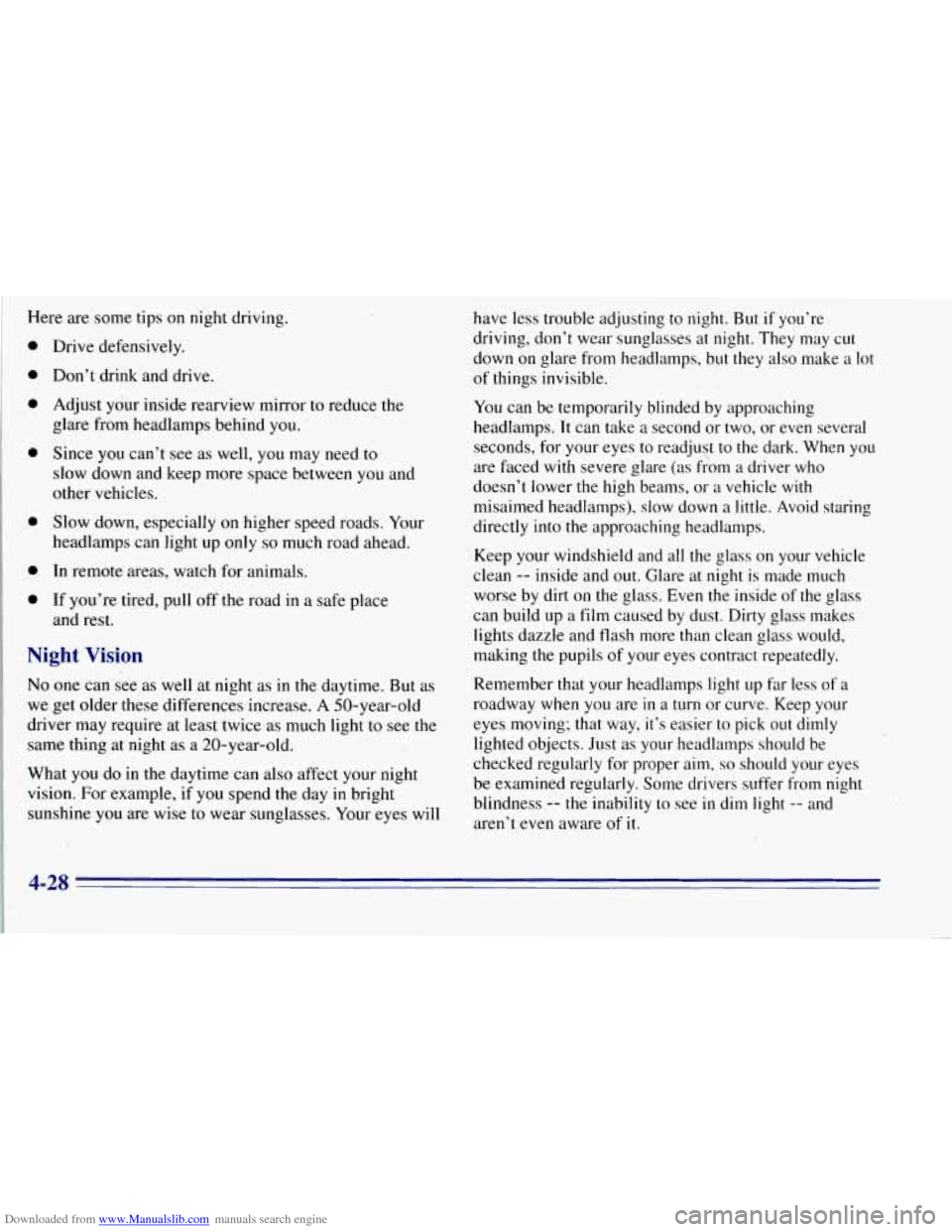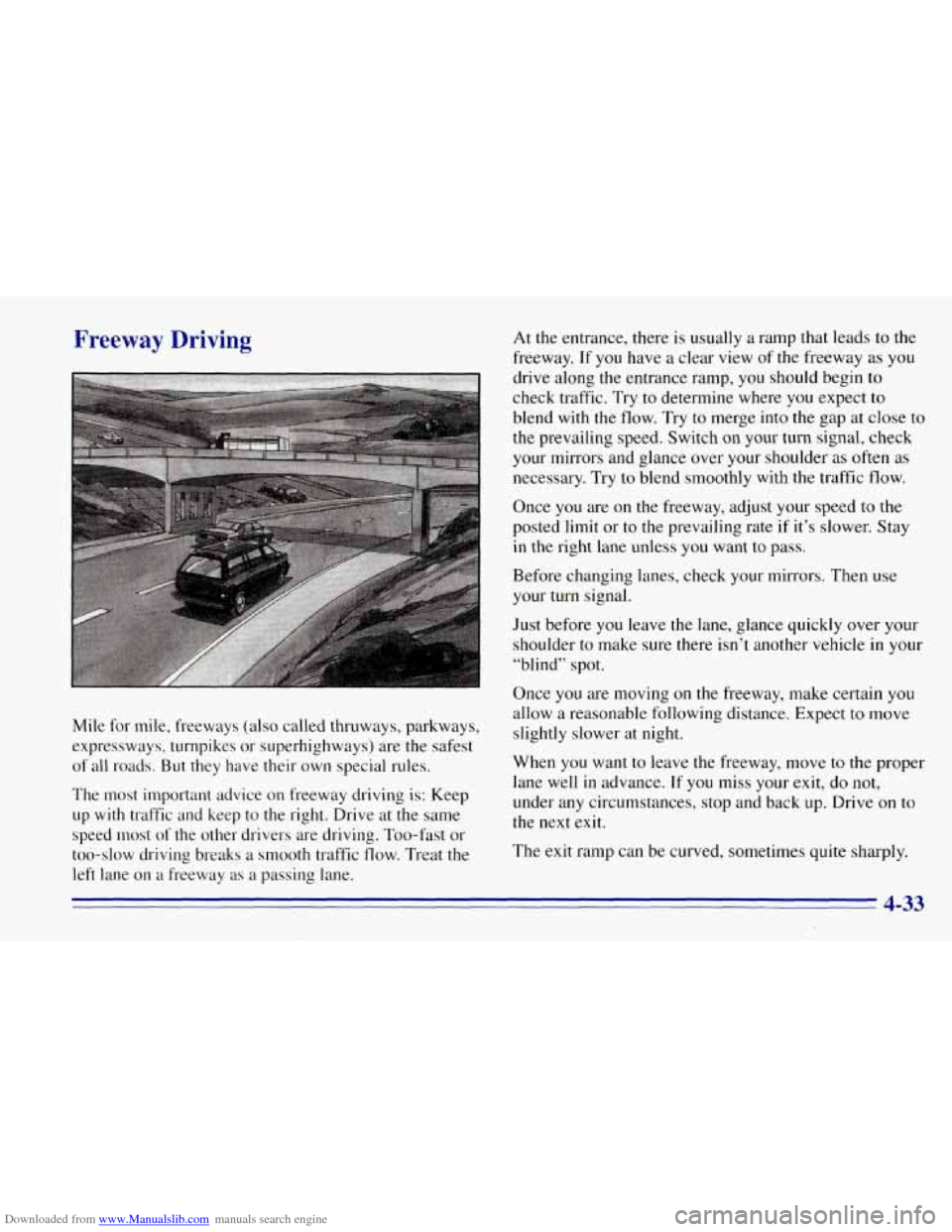Page 128 of 403

Downloaded from www.Manualslib.com manuals search engine - - ~~ ~- ~~ ~~
.. .
Have you recently changed brands of fuel?
If so, be sure to fuel your vehicle with quality fuel (see
"Fuel" in the .Index). Poor fuel quality will cause your
engine not to run as efficiently as designed. You may
notice this as stalling after start-up, stalling when you
put the vehicle into gear, misfiring, hesitation
on
acceleration or stumbling on acceleration. (These
conditions may go away once the engine is warmed up.)
This will be detected by the system and cause the light
to turn on.
If you experience this condition, change the fuel brand
you use. It will require at least one full tank of the
proper fuel to turn the light
off.
If none of the above steps have made the light turn off,
have your dealer or qualified service center check the
vehicle. Your dealer has the proper test equipment and
diagnostic tools to fix any mechanical or electrical
problems that may have developed.
Oil Pressure Gage
0 \ 80
The oil pressure gage
shows the engine oil
pressure in psi (pounds
per square inch) when the
engine is running. Canadian
vehicles indicate pressure
in kPa (kilopascals).
Oil pressure may vary with engine speed, outside
temperature and oil viscosity, but readings above the
low pressure zone indicate the normal operating range.
A reading in the low pressure zone may be caused by a
dangerously low oil level or other problem'causing low
oil pressure. Check your oil as soon as possible.
2-65
Page 129 of 403
Downloaded from www.Manualslib.com manuals search engine 1 CAUTION:
Don't keep driving if the oil pressure is low. If
you do, your engine can become so hot that it
catches fire. You or others could be burned.
Check your oil as soon
as possible and have your
vehicle serviced.
I NOTICE:
Damage to your engine from neglected oil
problems can be costly and
is not covered by
your warranty.
Daytime Running Lamps (DRL) Indicator Light
This light will go on
whenever the
DRL are on.
When it begins to get dark, the
DRL indicator light is a
reminder
to turn on your headlamps.
2-66
Page 130 of 403
Downloaded from www.Manualslib.com manuals search engine Check Gages Light
This light will come on
briefly when you are
starting the engine.
CHECK
GAGES
If the light comes on and stays on while you are driving,
it could indicate a problem with your vehicle. It could be
a problem with your oil pressure, coolant temperature,
or some other problem. Check your various gages to see
if they are in the warning zones.
If they are, have your
vehicle serviced right away.
Headlamp High-Beam Indicator Light
The high-beam indicator is
on whenever you use your
high-beam headlamps.
For
more details about high
beams,
see “Headlamp
HighLow Beam Changer”
earlier in this section.
Turn Signal and Lane Change
Indicator Lights
The signal indicator will
come on whenever
you
signal a turn or lane change.
See “Turn Signal and Lane
Change Indicator’’ earlier in
this section.
2-67
Page 159 of 403
Downloaded from www.Manualslib.com manuals search engine Care of Your Compact Discs
.Handle discs carefully. Store them in their original cases
or other protective cases and away from direct sunlight
and dust. If the surface of a disc is soiled, dampen a
clean, soft cloth in a mild, neutral detergent solution and
clean
it, wiping from the center to the edge.
Be sure never to touch
the signal surface when handling
discs. Pick up discs by grasping the outer edges or the
edge
of the hole and the outer edge.
Fixed Mast Antenna
The fixed mast antenna can withstand most vehicle
washes without being damaged. If the mast should ever
become slightly bent, you can straighten it out by hand,
If the mast is badly bent, as it might be by vandals, you
should replace it.
Check every once
in a while to be sure the mast is still
tightened to the cowl.
Page 165 of 403

Downloaded from www.Manualslib.com manuals search engine Avoid needless heavy braking. Some people drive in
spurts
-- heavy acceleration followed by heavy
braking
-- rather than keeping pace with traffic. This is a
mistake. Your brakes may not have time
to cool between
hard stops. Your brakes will wear out much faster if you
do a lot of heavy braking. If you keep pace with the
traffic and allow realistic following distances,
you will
eliminate a lot of unnecessary braking. That means
better braking and longer brake life.
Ilf your engine ever stops while you’re driving, brake
normally but don’t pump your brakes. If you do, the
pedal may get harder
to push down. If your engine
sto’ps,
you will still have some power brake assist. But
you will use it when you brake. Once the power assist is
used
up, it‘may take longer to stop and the brake pedal
will be harder to push.
Anti-Lock Brakes
Your vehicle has anti-lock brakes (ABS). ABS is an
advanced electronic braking system that will help
prevent a braking skid.
When you start your engine and begin to drive away,
your anti-lock brake system will check itself.
You may
hear a momentary motor or clicking noise while this test
is going on. This
is normal.
ANTI -
LOCK
If there’s a problem with the
anti-lock brake system, this
warning light will stay on.
See “Anti-Lock Brake
System Warning Light” in
the Index.
4-6
Page 187 of 403

Downloaded from www.Manualslib.com manuals search engine Here are-some tips on night driving.
0
0
0
0
0
0
0
Drive defensively.
Don’t ,drink and drive.
Adjust your inside rearview mirror to reduce the
glare from headlamps behind you.
.
Since you can’t see as well, you may need to
slow down and keep more space between you and
other vehicles.
Slow down, especially on higher speed roads. Your
headlamps can light up
only so much road ahead.
In remote areas, watch for animals.
If you’re tired, pull off the road in a safe place
and rest.
Night Vision
No one can see as well at night as in the daytime. But as
we get older these differences increase.
A 50-year-old
driver may require at least twice as much light to
see the
same thing at night as a 20-year-old.
What you do
in the daytime can also affect your night
vision. For example, if you spend the day in bright
sunshine you are wise to wear sunglasses. Your eyes will have less trouble adjusting to night.
But,if you’re
driving, don’t wear sunglasses at.night. They may cut
down on glare from headlamps, but they also make a
lot
of things invisible.
You can be temporarily blinded by approaching
headlamps. It can take a second or two, or even several
seconds, for your eyes to readjust to the dark. When you
are faced with severe glare (as from a driver who
doesn’t lower the high beams, or a vehicle
with
misaimed headlamps), slow down a little. Avoid staring
directly into the approaching headlamps.
Keep your windshield and all the glass on your vehicle
clean
-- inside and out. Glare at night is made much
worse by dirt
on the glass. Even the inside of the glass
can build up a film caused by dust. Dirty glass makes
lights dazzle and flash more than clean glass would,
making the pupils
of your eyes contract repeatedly.
Remember that your headlamps light up far less
of a
roadway when
you are in a turn or curve. Keep your
eyes moving; that way, it’s easier to pick out dimly
lighted objects. Just as your headlamps should be
checked regularly for proper aim,
so should your eyes
be examined regularly. Some drivers suffer from night
blindness
-- the inability to see in dim light -- and
aren’t even aware of it.
4-28
Page 191 of 403
Downloaded from www.Manualslib.com manuals search engine City Driving Here are ways to increase your safety in city driving:
e
0
0
Know the best way to get to where you are
going. Get a city map and plan your trip into an
unknown part of the city just as you would for a
cross-country trip.
Try to use the freeways that rim and crisscross most
large cities. You’ll save time and energy. (See the
next part, ‘‘Freeway Driving.”)
Treat a green light as a warning signal.
A traffic
light is there because the corner is busy enough to
need it. When a light turns green, and just before you
start to move, check both ways for vehicles that have
not cleared the intersection or may be running the
red light.
One ofthe biggest problems with city streets
is the
amount of traffic on them. You’ll want to watch out for
what the other drivers are doing and pay attention to
traffic signals.
4-32
Page 192 of 403

Downloaded from www.Manualslib.com manuals search engine Freeway Driving
Mile for mile, freeways (also called thruways, parkways,
expressways, turnpikes
or superhighways) are the safest
of all roads.
But they have their own special rules.
The most important advice on freeway driving
is: Keep
up with traffic and keep to the right. Drive at the same
speed most
of the other drivers are driving. Too-fast or
too-slow driving breaks
a smooth traffic flow. Treat the
left lane
on a freeway as a passing lane. At
the entrance, there is usually a ramp that leads
to the
freeway. If
you have a clear view of the freeway as you
drive along the entrance ramp, you should begin
to
check traffic. Try to determine where you expect to
blend with the flow. Try to merge.into the gap at close to
the prevailing speed. Switch on your turn signal, check
your mirrors and glance over your shoulder as often as
necessary. Try to blend smoothly with the traffic flow.
Once you are
on the freeway, adjust your speed to the
posted limit
or to the prevailing rate if it’s slower. Stay
in the right lane unless you want to pass.
Before changing lanes, check your mirrors.
Then use
your turn signal.
Just before
you leave the lane, glance quickly over your
shoulder
to make sure there isn’t another vehicle in your
“blind” spot.
Once you are moving on the freeway, make certain you
allow a reasonable following distance. Expect to move
slightly slower at night.
When you want to leave the freeway, move
to the proper
lane well in advance.
If you miss your exit, do not,
under any circumstances, stop and back
up. Drive on to
the next exit.
The exit ramp can be curved, sometimes quite sharply.
4-33